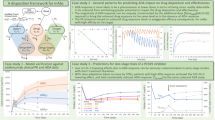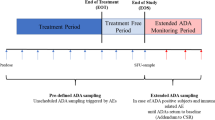Abstract
This article provides a theoretical case-study risk assessment report for a low-risk monoclonal antibody (mAb) therapeutic. In terms of risk, there are considerations around risks to safety, but also risks regarding effects on pharmacokinetics (PK), pharmacodynamics (PD), and efficacy. Much of the discussion in this document is around the risk of immunogenicity incidence. A higher incidence of immunogenicity would necessitate a detailed review of the PK, efficacy and safety in anti-drug antibody (ADA) positive and ADA negative subjects, in order to evaluate potential effects. The publication is intended to provide a framework of some the current thought processes around assessing immunogenicity risk and for building strategies to mitigate those risks. For this example, we have created a hypothetical antibody, ABC-123, targeting a membrane protein on antigen presenting cells, for the treatment of rheumatoid arthritis (RA). This hypothetical antibody therapeutic is provided as an example for the purposes of risk assessment for a low risk molecule, although any application of similar approach would be case by case.


Similar content being viewed by others
References
Koren E, Smith HW, Shores E, Shankar G, Finco-Kent D, Rup B, et al. Recommendations on risk-based strategies for detection and characterization of antibodies against biotechnology products. J Immunol Methods. 2008;333(1–2):1–9.
Shankar G, Pendley C, Stein KE. A risk-based bioanalytical strategy for the assessment of antibody immune responses against biological drugs. Nat Biotechnol. 2007;25(5):555–61.
Strand V, Balsa A, Al-Saleh J, Barile-Fabris L, Horiuchi T, Takeuchi T, et al. Immunogenicity of biologics in chronic inflammatory diseases: a systematic review. BioDrugs. 2017;31(4):299–316.
Nelson AL, Dhimolea E, Reichert JM. Development trends for human monoclonal antibody therapeutics. Nat Rev Drug Discov. 2010;9(10):767–74.
Araujo J, Zocher M, Wallace K, Peng K, Fischer SK. Increased rheumatoid factor interference observed during immunogenicity assessment of an fc-engineered therapeutic antibody. J Pharm Biomed Anal. 2011;55(5):1041–9.
Getts DR, Getts MT, McCarthy DP, Chastain EM, Miller SD. Have we overestimated the benefit of human(ized) antibodies? MAbs. 2010;2(6):682–94.
Harding FA, Stickler MM, Razo J, DuBridge RB. The immunogenicity of humanized and fully human antibodies: residual immunogenicity resides in the CDR regions. MAbs. 2010;2(3):256–65.
Caceres MC, Guerrero-Martin J, Perez-Civantos D, Palomo-Lopez P, Delgado-Mingorance JI, Duran-Gomez N. The importance of early identification of infusion-related reactions to monoclonal antibodies. Ther Clin Risk Manag. 2019;15:965–77.
Immunogenicity Testing of Therapeutic Protein Products —Developing and Validating Assays for Anti-Drug Antibody Detection [Internet]. 2019. Available from: https://www.fda.gov/regulatory-information/search-fda-guidance-documents/immunogenicity-testing-therapeutic-protein-products-developing-and-validating.
Guideline on Immunogenicity assessment of therapeutic proteins [Internet]. 2017. Available from: https://www.ema.europa.eu/en/documents/scientific-guideline/guideline-immunogenicity-assessment-therapeutic-proteins-revision-1_en.pdf.
Silva JP, Vetterlein O, Jose J, Peters S, Kirby H. The S228P mutation prevents in vivo and in vitro IgG4 fab-arm exchange as demonstrated using a combination of novel quantitative immunoassays and physiological matrix preparation. J Biol Chem. 2015;290(9):5462–9.
Mufarrege EF, Giorgetti S, Etcheverrigaray M, Terry F, Martin W, De Groot AS. De-immunized and functional therapeutic (DeFT) versions of a long lasting recombinant alpha interferon for antiviral therapy. Clin Immunol. 2017;176:31–41.
Joubert MK, Deshpande M, Yang J, Reynolds H, Bryson C, Fogg M, et al. Use of in vitro assays to assess immunogenicity risk of antibody-based biotherapeutics. PLoS One. 2016;11(8):e0159328.
Zhang T, Song X, Xu L, Ma J, Zhang Y, Gong W, et al. The binding of an anti-PD-1 antibody to FcgammaRI has a profound impact on its biological functions. Cancer Immunol Immunother. 2018;67(7):1079–90.
Herbener P, Schonfeld K, Konig M, Germer M, Przyborski JM, Bernoster K, et al. Functional relevance of in vivo half antibody exchange of an IgG4 therapeutic antibody-drug conjugate. PLoS One. 2018;13(4):e0195823.
OPDIVO (nivolumab) injection, for intravenous use [Internet]. 2018. Available from: https://www.accessdata.fda.gov/drugsatfda_docs/label/2018/125554s058lbl.pdf.
KEYTRUDA (pembrolizumab) for injection, for intravenous use [Internet]. 2019. Available from: https://www.accessdata.fda.gov/drugsatfda_docs/label/2019/125514Orig1s054lbl.pdf.
BESPONSA (inotuzumab ozogamicin) for injection, for intravenous use [Internet]. 2017. Available from: https://www.accessdata.fda.gov/drugsatfda_docs/label/2017/761040s000lbl.pdf.
Specifications: test procedures and acceptance criteria for biotechnological/biological products Q6B [Internet]. 1999. Available from: https://database.ich.org/sites/default/files/Q6B_Guideline.pdf.
Maser EA, Villela R, Silverberg MS, Greenberg GR. Association of trough serum infliximab to clinical outcome after scheduled maintenance treatment for Crohn's disease. Clin Gastroenterol Hepatol. 2006;4(10):1248–54.
Ordas I, Mould DR, Feagan BG, Sandborn WJ. Anti-TNF monoclonal antibodies in inflammatory bowel disease: pharmacokinetics-based dosing paradigms. Clin Pharmacol Ther. 2012;91(4):635–46.
Schreiber S, Khaliq-Kareemi M, Lawrance IC, Thomsen OO, Hanauer SB, McColm J, et al. Maintenance therapy with certolizumab pegol for Crohn's disease. N Engl J Med. 2007;357(3):239–50.
Maini RN, Breedveld FC, Kalden JR, Smolen JS, Davis D, Macfarlane JD, et al. Therapeutic efficacy of multiple intravenous infusions of anti-tumor necrosis factor alpha monoclonal antibody combined with low-dose weekly methotrexate in rheumatoid arthritis. Arthritis Rheum. 1998;41(9):1552–63.
Pouw MF, Krieckaert CL, Nurmohamed MT, van der Kleij D, Aarden L, Rispens T, et al. Key findings towards optimising adalimumab treatment: the concentration-effect curve. Ann Rheum Dis. 2015;74(3):513–8.
Zhuang Y, Xu Z, Frederick B, de Vries DE, Ford JA, Keen M, et al. Golimumab pharmacokinetics after repeated subcutaneous and intravenous administrations in patients with rheumatoid arthritis and the effect of concomitant methotrexate: an open-label, randomized study. Clin Ther. 2012;34(1):77–90.
Wang W, Leu J, Watson R, Xu Z, Zhou H. Investigation of the mechanism of therapeutic protein-drug interaction between methotrexate and Golimumab, an anti-TNFalpha monoclonal antibody. AAPS J. 2018;20(3):63.
Wu B, Chung S, Jiang XR, McNally J, Pedras-Vasconcelos J, Pillutla R, et al. Strategies to determine assay format for the assessment of neutralizing antibody responses to biotherapeutics. AAPS J. 2016;18(6):1335–50.
Peng K, Siradze K, Quarmby V, Fischer SK. Clinical immunogenicity specificity assessments: a platform evaluation. J Pharm Biomed Anal. 2011;54(3):629–35.
Carrasco-Triguero M, Dere RC, Milojic-Blair M, Saad OM, Nazzal D, Hong K, et al. Immunogenicity of antibody-drug conjugates: observations across eight molecules in eleven clinical trials. Bioanalysis. 2019.
Qiu ZJ, Ying Y, Fox M, Peng K, Lewin-Koh SC, Coleman D, et al. A novel homogeneous biotin-digoxigenin based assay for the detection of human anti-therapeutic antibodies in autoimmune serum. J Immunol Methods. 2010;362(1–2):101–11.
Gross J, Moller R, Henke W, Hoesel W. Detection of anti-EPO antibodies in human sera by a bridging ELISA is much more sensitive when coating biotinylated rhEPO to streptavidin rather than using direct coating of rhEPO. J Immunol Methods. 2006;313(1–2):176–82.
Mikulskis A, Yeung D, Subramanyam M, Amaravadi L. Solution ELISA as a platform of choice for development of robust, drug tolerant immunogenicity assays in support of drug development. J Immunol Methods. 2011;365(1–2):38–49.
Shankar G, Devanarayan V, Amaravadi L, Barrett YC, Bowsher R, Finco-Kent D, et al. Recommendations for the validation of immunoassays used for detection of host antibodies against biotechnology products. J Pharm Biomed Anal. 2008;48(5):1267–81.
Devanarayan V, Smith WC, Brunelle RL, Seger ME, Krug K, Bowsher RR. Recommendations for systematic statistical computation of immunogenicity cut points. AAPS J. 2017;19(5):1487–98.
FDA. S6 Addendum to Preclinical Safety Evaluation of Biotechnology-Derived Pharmaceuticals. 2012.
REMICADE (infliximab) Lyophilized Concentrate for Injection, for Intravenous Use [Internet]. 2013. Available from: https://www.accessdata.fda.gov/drugsatfda_docs/label/2013/103772s5359lbl.pdf.
RITUXAN (rituximab) Injection for Intravenous Use [Internet]. 2010. Available from: https://www.accessdata.fda.gov/drugsatfda_docs/label/2010/103705s5311lbl.pdf.
Roskos LK, Davis CG, Schwab GM. The clinical pharmacology of therapeutic monoclonal antibodies. Drug Dev Res. 2004;61(3):108–20.
Robbie GJ, Criste R, Dall'acqua WF, Jensen K, Patel NK, Losonsky GA, et al. A novel investigational fc-modified humanized monoclonal antibody, motavizumab-YTE, has an extended half-life in healthy adults. Antimicrob Agents Chemother. 2013;57(12):6147–53.
Griffin MP, Khan AA, Esser MT, Jensen K, Takas T, Kankam MK, et al. Safety, Tolerability, and Pharmacokinetics of MEDI8897, the Respiratory Syncytial Virus Prefusion F-Targeting Monoclonal Antibody with an Extended Half-Life, in Healthy Adults. Antimicrob Agents Chemother. 2017;61(3).
Gaudinski MR, Coates EE, Houser KV, Chen GL, Yamshchikov G, Saunders JG, et al. Safety and pharmacokinetics of the fc-modified HIV-1 human monoclonal antibody VRC01LS: a phase 1 open-label clinical trial in healthy adults. PLoS Med. 2018;15(1):e1002493.
Rother RP, Rollins SA, Mojcik CF, Brodsky RA, Bell L. Discovery and development of the complement inhibitor eculizumab for the treatment of paroxysmal nocturnal hemoglobinuria. Nat Biotechnol. 2007;25(11):1256–64.
SOLIRIS™ (eculizumab) Concentrated solution for intravenous infusion [Internet]. 2007. Available from: https://www.accessdata.fda.gov/drugsatfda_docs/label/2007/125166lbl.pdf.
Kuriakose A, Chirmule N, Nair P. Immunogenicity of biotherapeutics: causes and association with posttranslational modifications. J Immunol Res. 2016;2016:1298473.
Vanderlaan M, Zhu-Shimoni J, Lin S, Gunawan F, Waerner T, Van Cott KE. Experience with host cell protein impurities in biopharmaceuticals. Biotechnol Prog. 2018;34(4):828–37.
Fischer SK, Cheu M, Peng K, Lowe J, Araujo J, Murray E, et al. Specific immune response to phospholipase B-like 2 protein, a host cell impurity in Lebrikizumab clinical material. AAPS J. 2017;19(1):254–63.
Alt N, Zhang TY, Motchnik P, Taticek R, Quarmby V, Schlothauer T, et al. Determination of critical quality attributes for monoclonal antibodies using quality by design principles. Biologicals. 2016;44(5):291–305.
ICH Quality Implementation Working Group, Points To Consider (R2); ICH-Endorsed Guide ForICH Q8/Q9/Q10 Implementation [Internet]. 2011. Available from: http://www.ich.org/fileadmin/Public_Web_Site/ICH_Products/Guidelines/Quality/Q8_9_10_QAs/PtC/Quality_IWG_PtCR2_6dec2011.pdf.
van Brummelen EM, Ros W, Wolbink G, Beijnen JH, Schellens JH. Antidrug antibody formation in oncology: clinical relevance and challenges. Oncologist. 2016;21(10):1260–8.
Davda J, Declerck P, Hu-Lieskovan S, Hickling TP, Jacobs IA, Chou J, et al. Immunogenicity of immunomodulatory, antibody-based, oncology therapeutics. J Immunother Cancer. 2019;7(1):105.
Talotta R, Rucci F, Canti G, Scaglione F. Pros and cons of the immunogenicity of monoclonal antibodies in cancer treatment: a lesson from autoimmune diseases. Immunotherapy. 2019;11(3):241–54.
Deng R, Bumbaca D, Pastuskovas CV, Boswell CA, West D, Cowan KJ, et al. Preclinical pharmacokinetics, pharmacodynamics, tissue distribution, and tumor penetration of anti-PD-L1 monoclonal antibody, an immune checkpoint inhibitor. MAbs. 2016;8(3):593–603.
SYNAGIS® (palivizumab) injection, for intramuscular use [Internet]. 2014. Available from: https://www.accessdata.fda.gov/drugsatfda_docs/label/2014/103770s5185lbl.pdf.
ZINPLAVA™ (bezlotoxumab) injection, for intravenous use [Internet]. 2016. Available from: https://www.accessdata.fda.gov/drugsatfda_docs/label/2016/761046s000lbl.pdf.
Montgomery DL, Matthews RP, Yee KL, Tobias LM, Dorr MB, Wrishko RE. Assessment of Bezlotoxumab Immunogenicity. Clin Pharmacol Drug Dev. 2019.
Markham A. Ibalizumab: First Global Approval. Drugs. 2018;78(7):781–5.
REPATHA (evolocumab) injection, for subcutaneous use [Internet]. 2017. Available from: https://www.accessdata.fda.gov/drugsatfda_docs/label/2017/125522s014lbl.pdf.
PRALUENT (alirocumab) injection, for subcutaneous use [Internet]. 2015. Available from: https://www.accessdata.fda.gov/drugsatfda_docs/label/2015/125559Orig1s000lbledt.pdf.
Ridker PM, Tardif JC, Amarenco P, Duggan W, Glynn RJ, Jukema JW, et al. Lipid-reduction variability and antidrug-antibody formation with bococizumab. N Engl J Med. 2017;376(16):1517–26.
Kopylov U, Ben-Horin S, Seidman E. Therapeutic drug monitoring in inflammatory bowel disease. Ann Gastroenterol. 2014;27(4):304–12.
Chung CH, Mirakhur B, Chan E, Le QT, Berlin J, Morse M, et al. Cetuximab-induced anaphylaxis and IgE specific for galactose-alpha-1,3-galactose. N Engl J Med. 2008;358(11):1109–17.
Author information
Authors and Affiliations
Corresponding author
Additional information
Guest Editor: Johanna Mora
Publisher’s Note
Springer Nature remains neutral with regard to jurisdictional claims in published maps and institutional affiliations.
Electronic supplementary material
ESM 1
(DOCX 24 kb)
Rights and permissions
About this article
Cite this article
Kernstock, R., Sperinde, G., Finco, D. et al. Clinical Immunogenicity Risk Assessment Strategy for a Low Risk Monoclonal Antibody. AAPS J 22, 60 (2020). https://doi.org/10.1208/s12248-020-00440-5
Received:
Accepted:
Published:
DOI: https://doi.org/10.1208/s12248-020-00440-5




